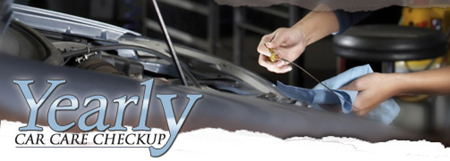
Keep
Your Car Reliable with Yearly Checkups
Now
or never. It is once again the time of year for those basic car care maintenance
checkups. According to the Car Care Council (CCC), basic annual maintenance, such
as checking oil levels, can help improve vehicle safety and reliability. Additionally,
these checkups can help you avoid costly repairs over the life of your vehicle.
The
CCC recommends drivers perform 10 basic maintenance procedures throughout the
year to help keep their vehicles opperating properly.
Check
oil, filters and fluids. Check your oil whenever you fill-up. Also,
for maximum engine life, your vehicle's oil should be changed according to the
owner's manual recommendations, or every three months or 3,000 miles. Brake, transmission,
power steering, coolant and windshield washer fluids should also be checked regularly.
Your vehicle's filters — including those for the transmission, fuel system
and interior ventilation — need regular inspection and replacement.
Inspect
hoses. At each oil change, check your hoses and have them replaced
if they are leaking, brittle, cracked, rusted, swollen or restricted. Also, check
V-belts and serpentine belts for looseness and condition, replacing them when
cracked, frayed, glazed or excessively worn.
Typically,
vehicle timing belts are replaced between 60,000 and 90,000 miles, or at the intervals
suggested in the owner's manual. Changing these belts helps you avoid causing
serious engine damage, which could lead to a breakdown.
Check
the engine brake system. Check this system every year, and have the
brake linings, rotors and drums inspected during each oil change.
Check
the battery connection. The battery should be securely mounted and
corrosion-free. Every three years, the battery should be tested and replaced if
not working properly.
Inspect
the exhaust system. Check your vehicle's exhust system for leaks, damage
and broken supports or hangers. These problems may cause unusal noises while driving.
Exhaust leaks can be dangerous, and should be corrected immediately if found.
Schedule
a tune-up. Regular checkups ensure the car's engine is delivering the
best balance of power and fuel economy, producing low level of emissions.
Check
the car's HVAC system. Ensure the heating, ventilating and air conditioning
(HVAC) system is properly heating and cooling the vehicle. This performance is
critical for not only interior comfort, but also safety reasons such as defrosting
your windows.
Inspect
the steering and suspension system. Every year, check your vehicle's
steering and suspension systems, including shock absorbers, struts and chassis
parts such as ball joints, tie rod ends and other related components.
Monitor
tire pressure. Check your vehicle's tire pressure at least once a month.
Make sure you also check the tire treads for uneven or irregular wear and cuts
along the sidewalls. Additionally, check your car's alignment annually to reduce
tire wear and improve fuel economy and handling.
Test
exterior and interior lights. Replace any bulbs that are not working
immediately. Also, replace windshield wiper blades every six months, or when they
are cracked, cut, torn, streaking or chattering. This ensures optimum performance
and safety.
Source — Car
Care Council
|